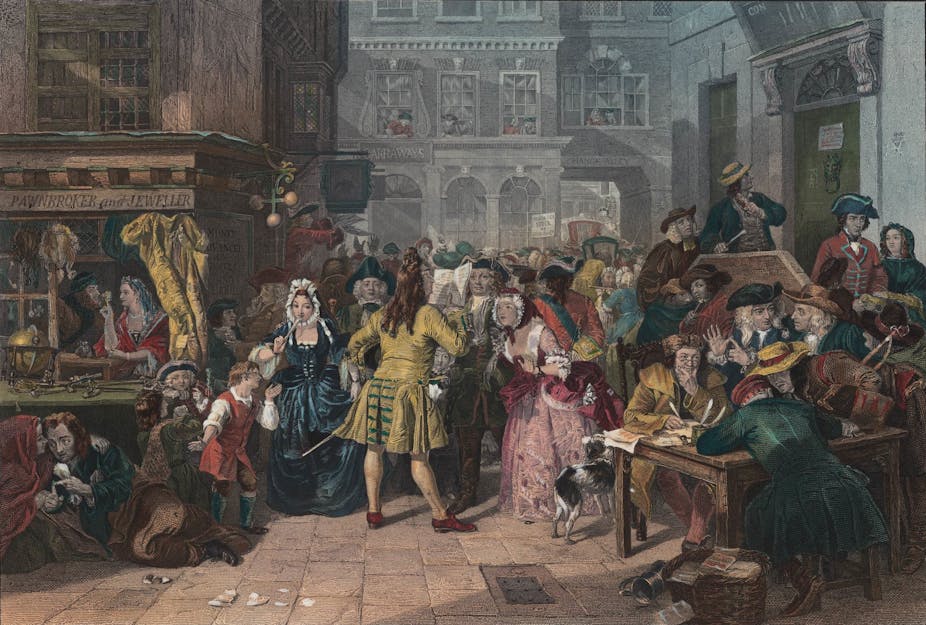So just how do you reduce the risk of crisis in financial markets? In the aftermath of the South Sea Bubble of 1720, contemporaries reached a firm but controversial conclusion: keep women out.
The South Sea Bubble was one of Britain’s first stock market manias. The South Sea Company was established in 1711 and, despite a remit to trade to South America, its main activity was converting the state’s expensive and difficult to manage debt into Company shares. The Bank of England had set the precedent in this kind of operation. And the conversions were very effective. They reduced costs for the state and brought easy profits to both the Bank and the South Sea Company.
Indeed, the schemes proved so profitable that, at the end of 1719, the South Sea Company hatched an ambitious plan to convert all outstanding government debt – except that held by the Bank of England – to Company shares. The difference in 1719 was the scale and a scheme that incentivised the South Sea Company to push share prices as high as possible.
As a consequence, over the spring and summer of 1720 prices rose, speculation became fashionable and anyone who was anyone wanted to own South Sea shares. Dozens of other new joint-stock companies sprang up in its wake and encouraged new investors into the market. By the autumn, of course, the bubble had burst – the speculators lost their illusions of immense wealth and parliament was trying to bring criminal charges against the directors of the South Sea Company.
After the collapse of Lehman Brothers in 2008, the then French finance minister (later to become head of the IMF) Christine Lagarde suggested that it could not have happened if the bank had been Lehman Sisters. In the wake of the South Sea Bubble, the opposite conclusion was reached. The financial market was certainly male-dominated – but the passions that gripped it during 1720 were commonly described as feminine: hysterical and irrational.
The mania, they believed, had not resulted from increased testosterone levels. It had, in fact, “unmanned” investors – robbing them of their masculinity and hence the ability to act rationally. In his pamphlet A Learned Dissertation Upon Old Women, Thomas Gordon ranted:
We are enchanted by a stupid kennel of Stock-Jobbers, who cheat us out of our money and our sex.
He advised his countrymen to “either properly and patiently put on Petticoats; or resume our Manhood and shake off this shameful Delusion, this filthy Yoke…”
The South Sea Company was likewise feminised as a way of demonstrating the transgressions of its directors. In another pamphlet, written in 1720 and entitled The South-Sea Scheme Detected, the author – who went by the pen-name “A Lover of his Country” – suggested:
The Chief Managers of a certain Stock, may dress up their Darling Mistress once more, and send her into the World not without a tempting Aspect; but People who have already been Sufferers by their Schemes, will look upon her with a cautious Eye. A fine Lady, who had deceived a Man once, will for the Future be treated as a common Prostitute.
Monstrous regiment
Women investors – and there were plenty of those – were subjected to the same criticisms. One newspaper, The Weekly Journal, reported, as the bubble collapsed: “We have been ruined by Whores; nay what is more vexatious, old ugly Whores!”

The king’s mistress, the Duchess of Kendal, was implicated in the cover-up of the company’s activities that followed. In this satire, she is depicted handing papers to Robert Knight, the South Sea Company’s cashier and the man who knew where all the bodies were buried, to facilitate his escape to the continent.
Female investors, far from being regarded as a stabilising influence, were characterised as manipulators of the market. They enjoyed playing the markets and sought out the independence and power that might come from successful speculation. In William Chetwood’s play, The stock-jobbers, or, The humours of Exchange-Alley, a group of women rent a shop in order that they might pursue their business in the markets away from the interference of men. These women would let no man into their company since, as one of the characters, Lady Love-Picket, declared:
I do not see why these Wretches should monopolize the Pleasure of Business to themselves, it is only to keep us in Ignorance of all that’s Charming in Life.
The aim of their speculations was to make enough to take control of their lives. In the Original Weekly Journal of August 1720 the undoubtedly fictitious Florentina demonstrated just how that might be achieved. She wrote of her success in the South Sea Scheme and her determination that her profits would be used to “purchase” a husband – a “South-Sea match”. She simply lacked advice on how much to pay and where to find one that was worth the money.
The history of the South Sea Bubble reveals many women who made money and a good many who lost out. In the end, the objections directed against them in newspapers and satires reveals little about their trading prowess and much more about a patriarchal society’s fear of powerful women whatever the source of their power or the ends to which it was directed.
They also tell us that explanations for booms and busts that rely on the condemnation of particular personalities are shaped by the anxieties of the times and, as such, have little value. If we seek to control financial markets, we need to look beyond the character traits of their participants.

